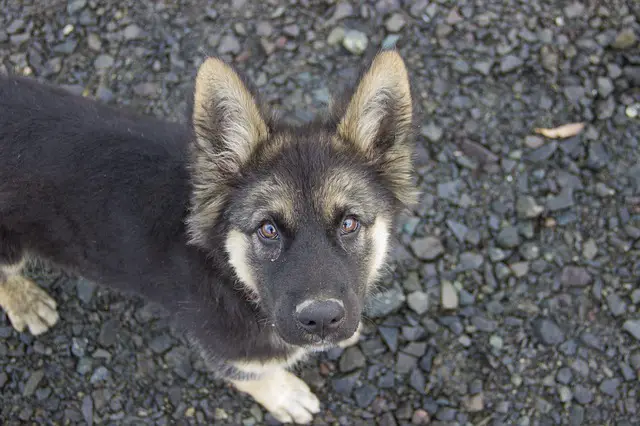Miniature German Shepherds are like Unicorns and Santa, they don’t actually exist! Well, at least not technically.
In this guide, we look over some general information and FAQs about Miniature German Shepherds.
We discuss dwarfism, Mini GSD Mix breeds, and more.
Let’s take a look!
(NOTE: this is a general information guide only, and is not professional advice, or a substitute for professional advice. A qualified vet or animal expert is the only person qualified to give you expert advice in regards to your pet/s)
Miniature German Shepherds: FAQ Guide
What Types Of German Shepherds Actually Exist?
What you will read is that a Miniature German Shepherd is not an official or recognized type of German Shepherd.
What Should A Regular German Shepherd Technically Look Like?
You might go according to breed standards.
According to the American Kennel Association standard, a purebred German Shepherd is 22-26 inches tall (55 to 65 cms), and 49-88 lbs (22 to 40 kgs) in weight, depending if it’s male or female.
The miniature german shepherd is likely a term coined by breeders cashing in on the mini-dog fad, but the exact origin of the phrase is not known.
A GSD (German Shepherd Dog) that is miniature, or more accurately an abnormally small German Shepherd is most likely:
– a GSD hybrid/mix
– OR, has dwarfism (according to buzzle.com)
Miniature German Shepherd Mix
Other sources might say mixed Miniature German Shepherds are usually a GSD mix Poodle, or GSD mix Border Collie.
But, average Shepadoodles and Shollies are both large dogs.
Smaller GSD mix breeds might be the Chow Chow, Corgi, or even the Beagle.
One thing that is sure is that a small GSD mix occurs when the German Shepherd is bred with a smaller dog and the smaller dog’s genes are dominant.
If you own one of these dog, it will likely have some or all of the GSD’s personality and temperament traits depending on which breed has the dominant genes.
When considering a mix breed GSD, it is wise to do your research and be prepared.
Certain combinations can produce different dogs, and it depends on your situation as to which suits you best.
The health and well being of the dog should always come first though.
We have some German Shepherd Mix articles on our site if you want to read more about them. Use the search bar on the right hand side of this article.
Dwarfism in Miniature German Shepherds
The unique and interesting thing about Pituitary Dwarfism in GSDs is that the body is completely and perfectly proportioned, except the dog is significantly smaller than a purebred.
In other dogs like Dachshunds and Basset Hounds for example, dwarfism causes normal sized torsos and shortened limbs.
Poodles with dwarfism suffer from limb disproportion and abnormalities in their DNA makeup, which causes conditions and diseases.
GSD’s with dwarfism are not without their problems. They can be sterile, suffer from hair loss and be susceptible to other conditions.
Miniature/Small German Shepherds For Sale – Should You Buy One?
A ‘Miniature German Shepherd’ for sale might raise alarm bells based on what you have rad above.
You have to ask yourself how the dog has been bred, who the breeders are, and what genetic material might actually be in the dog.
At the very least – you may want to deeply research a dog and breeder like this.
If you really want a small German Shepherd, you should consider what you want in your dog, and what your values and beliefs are.
Any breeding should always be done with the health of the parents and puppies being the main priority.
If you want a more common dog with less chance of health related issues, a mix GSD is probably the way to go (although some people believe only purebreds should be bred together).
Unless the breeder is breeding two GSDs with dwarfism together, it’s unlikely you are going to find a small GSD near you.
If you do buy a small or miniature German Shepherd, you have to ask yourself if you are ok with vet bills to deal with their potential array of health issues, and whether you believe it’s morally right to breed GSDs with dwarfism together.
Is it ok to breed dogs that might be more prone to poor health and a lower quality life?
It’s also likely your GSD with dwarfism won’t live as long as a purebred or mix breed dog without any of the likely genetic setbacks.
Ultimately, there’s a higher chance owning a GSD with dwarfism is going to take more of your time, love, money and care, and moral judgement.
What To Look For When Buying A German Shepherd
In this guide, we discuss what you might look for when buying a GSD, and also ethical considerations.
More Information & Facts About The German Shepherd Dog Breed
We’ve put together this guide with over 100 interesting pieces of information and facts about the German Shepherd Dog Breed.
Friendly Disclaimer
TheDailyShep.com are not veterinarians, or animal professionals/experts. Information provided is for informational purposes only – it is not a substitute for professional or qualified advice.
The information is based on either our own thorough research, and/or own experiences, as a means of free speech.
By consuming this information, you accept that TheDailyShep.com do not have client or patient relationship with you, and TheDailyShep.com are not advising you to act on anything you read.
You should always consult your own veterinarian, animal expert, or health care professional and follow their advice before making decisions on all matters.
You can find our full set of disclaimers and T & C’s in the footer of this site.
Enjoy your reading, and thank you for being here
','' ); } ?>